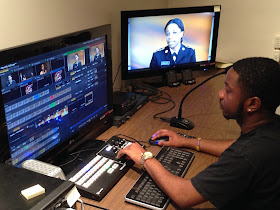In my TV production class this semester we are learning about video sequence shooting, or what the author of this article calls the "five shot method." By whatever name, the thought process involves planning shots, step-by-step and seeing the video in your mind before and during the shoot.
For my example, I chose to show five steps involved in turning on the department's TV studio:
Wide Shot: This is a wide shot of the TV studio in use. I would use this shot first in a sequence because it lets the viewer see right away where the action is taking place.
Medium Shot: Now we take you inside the control room where the director/switcher runs the show! A microphone-headset connection allows the director and/or other control room people to communicate with the camera operates and "talent" on the set.
Medium Shot: We clearly see both the interviewer, Destinee Chambliss, and her guest Jessica Edwards, an ROTC student at SC State.
The studio is green so that different sets can be brought up digitally. Click here for more on green screen effects.
Close-up Shot: Tight shot through a monitor of Jessica Edwards, with her name at the bottom. The Tricaster video producer is used to create the "virtual set" background by way of chroma key technology.
A true behind-the-scenes- image from behind the set with a view of the studio cameras, the crew operating them, and some studio lights.
Thursday, August 27, 2015
Tuesday, August 25, 2015
Communications' Television Studio In Action!
In this video, we see the steps involved in setting up the very fine TV studio on the second floor of Crawford Communications on the campus of South Carolina State University.
Once the studio and control room are prepared, it's time for...Lights...Cameras....Action!!!
The NewTek Tricaster allows for use of virtual sets and the switching among the three studio cameras. I'ts a real neat systems that, with a little bit of training, has the students doing lots of interviews and other projects.
Once the studio and control room are prepared, it's time for...Lights...Cameras....Action!!!
The NewTek Tricaster allows for use of virtual sets and the switching among the three studio cameras. I'ts a real neat systems that, with a little bit of training, has the students doing lots of interviews and other projects.
Thursday, August 20, 2015
Improvements in the Communications Program!
Over the summer there were many improvements to the Communication Program's second floor classrooms, labs and other facilities in the old Crawford Engineering Building. Plus, a new staff member has been added to assist in all areas of students services and faculty support.
A major upgrade is in the three main classrooms, rooms 203, 205 and 208. New StarBoard systems have been added.
A major upgrade is in the three main classrooms, rooms 203, 205 and 208. New StarBoard systems have been added.




